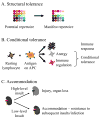Escaping from rejection
- PMID: 19996920
- PMCID: PMC2791908
- DOI: 10.1097/TP.0b013e3181bcc93a
Escaping from rejection
Abstract
Since the earliest days of transplantation, immunobiologists have sought means to prevent recognition and rejection of foreign tissue. The goal of these strategies is the retention of recipient immune function while selectively avoiding graft injury. Although considerable theoretical and technical problems remain, an analogous problem and solution already exists in nature. Here, we discuss the mechanisms by which organisms preclude or control autotoxicity, and for each, consider the corollaries between prevention of autotoxicity and graft rejection. Further study of these controls, including structural and conditional tolerance and accommodation, will offer insight into new therapies for allo- and xenotransplantation.
Figures

Similar articles
-
Kidney xenotransplantation.Kidney Int. 2014 Feb;85(2):265-75. doi: 10.1038/ki.2013.381. Epub 2013 Oct 2. Kidney Int. 2014. PMID: 24088952 Free PMC article. Review.
-
Xenotransplantation: immunological hurdles and progress toward tolerance.Immunol Rev. 2014 Mar;258(1):241-58. doi: 10.1111/imr.12152. Immunol Rev. 2014. PMID: 24517437 Free PMC article. Review.
-
Harnessing Mechanisms of Immune Tolerance to Improve Outcomes in Solid Organ Transplantation: A Review.Front Immunol. 2021 Jun 10;12:688460. doi: 10.3389/fimmu.2021.688460. eCollection 2021. Front Immunol. 2021. PMID: 34177941 Free PMC article. Review.
-
Immunological challenges and therapies in xenotransplantation.Cold Spring Harb Perspect Med. 2014 Apr 1;4(4):a015578. doi: 10.1101/cshperspect.a015578. Cold Spring Harb Perspect Med. 2014. PMID: 24616201 Free PMC article. Review.
-
Immunology in corneal transplantation-From homeostasis to graft rejection.Transplant Rev (Orlando). 2025 Apr;39(2):100909. doi: 10.1016/j.trre.2025.100909. Epub 2025 Jan 9. Transplant Rev (Orlando). 2025. PMID: 39798206 Review.
Cited by
-
Islets transplanted in immunoisolation devices: a review of the progress and the challenges that remain.Endocr Rev. 2011 Dec;32(6):827-44. doi: 10.1210/er.2010-0026. Epub 2011 Sep 27. Endocr Rev. 2011. PMID: 21951347 Free PMC article. Review.
-
Accommodation in renal transplantation: unanswered questions.Curr Opin Organ Transplant. 2010 Aug;15(4):481-5. doi: 10.1097/MOT.0b013e32833b9c25. Curr Opin Organ Transplant. 2010. PMID: 20613524 Free PMC article. Review.
-
Accommodation in ABO-incompatible organ transplants.Xenotransplantation. 2018 May;25(3):e12418. doi: 10.1111/xen.12418. Xenotransplantation. 2018. PMID: 29913044 Free PMC article. Review.
-
Donor specific antibodies after transplantation.Pediatr Transplant. 2011 Nov;15(7):686-90. doi: 10.1111/j.1399-3046.2010.01436.x. Epub 2011 Mar 29. Pediatr Transplant. 2011. PMID: 22004543 Free PMC article. Review.
-
Accommodation and related conditions in vascularized composite allografts.Curr Opin Organ Transplant. 2017 Oct;22(5):470-476. doi: 10.1097/MOT.0000000000000446. Curr Opin Organ Transplant. 2017. PMID: 28682798 Free PMC article. Review.
References
-
- Ehrlich P, Morgenroth J. Studies on haemolysins. In: Ehrlich P, editor. Studies in Immunity. New York: Wiley; 1910. p. 82.
-
- Sponaas AM, Tomlinson PD, Schulz R, et al. Tolerance induction by elimination of subsets of self-reactive thymocytes. Int Immunol. 1994;6 (10):1593. - PubMed
-
- McHeyzer-Williams MG, Nossal GJ. Clonal analysis of autoantibody-producing cell precursors in the preimmune B cell repertoire. J Immunol. 1988;141 (12):4118. - PubMed
-
- Ehrlich P. On immunity with special reference to cell life. Proceedings of the Royal Society of London. 1900;66:424.
-
- Robinson JH, Owen JJ. Transplantation tolerance induced in foetal mouse thymus in vitro. Nature. 1978;271 (5647):758. - PubMed
Publication types
MeSH terms
Grants and funding
LinkOut - more resources
Full Text Sources

